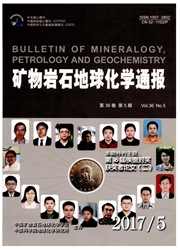

 中文摘要:
中文摘要:
为研究木祖克铅锌矿床成因,探讨成矿流体特征及其演化规律,本文在野外地质调查的基础上,对成矿各阶段脉石矿物的流体包裹体进行了研究.结果表明,热液矿物中的包裹体类型丰富,主要为气液水两相包裹体和含NaCl子矿物的多相包裹体,后者主要发育于Ⅰ阶段石榴子石和Ⅱ阶段绿帘石中.由Ⅰ→Ⅱ→Ⅲ→Ⅳ阶段,包裹体均一温度(330~568℃→299~416℃→181~320℃→137~196℃)和盐度(38.8%~49.8%NaCleq→34.8%~38.4%NaCleq→1.4%~11.46% NaCleq→1.1%~5.6 %NaCleq)有明显降低趋势.Ⅰ阶段石榴子石和Ⅱ阶段绿帘石中发育气液水包裹体和含NaCl子晶的多相包裹体,Ⅲ阶段石英中的气液水包裹体与同期次的纯液相水包裹体、纯气相水包裹体共生,且均一温度相近;各阶段成矿流体均发生过不混溶作用,其中Ⅲ阶段成矿流体的不混溶作用导致方铅矿、闪锌矿等的析出并富集成矿.
 英文摘要:
英文摘要:
In order to find out the origin of the Muzuke Pb-Zn deposit,characteristics and the evolutional laws of ore-forming fluids,in the paper we research into the fluid inclusions of all stages of the gangue minerals based on the survey of field geology characteristics.Petrographic observations revealed that various types of fluid inclusions present in hydrothermal minerals of different ore-forming stages,comprising mainly vapor-liquid two-phase inclusions and NaCl daughter mineral-bearing multiphase inclusions,subordinately mono-phase liquid and vapor inclusions,and occasionally organic vapor inclusions.NaCl daughter mineral-bearing multiphase inclusions are abundant in garnet (Ⅰ) and in epidote (Ⅱ).The homogenization temperature of the aqueous fluid inclusions decreases from stage Ⅰ (330-568℃),through stage Ⅱ (299-416℃),and Ⅲ (181-320℃),to stage Ⅳ (137-196℃) as well as the salinity of the aqueous fluid inclusions decreases from stage Ⅰ (38.8%-49.8%NaCleq),through stage Ⅱ (34.8% -38.4%NaCleq),and Ⅲ (1.4%-11.46%NaCleq),to stage Ⅳ (1.1%-5.6%NaCleq).The NaCl daughter mineral bearing multiphase inclusions with simultaneously trapped vapor or liquid rich two phase aqueous inclusions in garnet and epidote of stages Ⅰ and Ⅱ suggests an immiscibility hydrothermal fluid.In the quartz of stage Ⅲ,the aqueous fluid inclusions with various vapor/liquid ratios commonly coexist with simultaneously trapped mono-phase liquid inclusions and vapor inclusions,and different kinds of fluid inclusions have similar homogenization temperatures.This indicates that boiling extensively took place at stage Ⅲ.It suggested that the fluid immiscibility (boiling) of stage Ⅲ resulted in metal sulfide precipitation,enrichment and mineralization in this deposit.
 同期刊论文项目
同期刊论文项目
 同项目期刊论文
同项目期刊论文
 期刊信息
期刊信息
